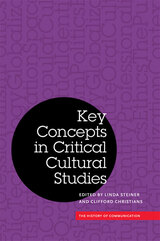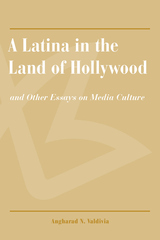2 books by Valdivia, Angharad N.

Key Concepts in Critical Cultural Studies
Edited by Linda Steiner and Clifford Christians
University of Illinois Press, 2010
This volume brings together sixteen essays on key and intersecting topics in critical cultural studies from major scholars in the field. Taking into account the vicissitudes of political, social, and cultural issues, the contributors engage deeply with the evolving understanding of critical concepts such as history, community, culture, identity, politics, ethics, globalization, and technology. The essays address the extent to which these concepts have been useful to scholars, policy makers, and citizens, as well as the ways they must be rethought and reconsidered if they are to continue to be viable. Each essay considers what is known and understood about these concepts. The essays give particular attention to how relevant ideas, themes, and terms were developed, elaborated, and deployed in the work of James W. Carey, the "founding father" of cultural studies in the United States. The contributors map how these important concepts, including Carey's own work with them, have evolved over time and how these concepts intersect. The result is a coherent volume that redefines the still-emerging field of critical cultural studies. Contributors are Stuart Allan, Jack Zeljko Bratich, Clifford Christians, Norman Denzin, Mark Fackler, Robert Fortner, Lawrence Grossberg, Joli Jensen, Steve Jones, John Nerone, Lana Rakow, Quentin J. Schultze, Linda Steiner, Angharad N. Valdivia, Catherine Warren, Frederick Wasser, and Barbie Zelizer.
[more]

A Latina in the Land of Hollywood
and Other Essays on Media Culture
Angharad N. Valdivia
University of Arizona Press, 2000
From ads for Victoria's Secret to the character roles of Rosie Perez, the mass media have been defining race and femininity. In this diverse set of essays, Angharad N. Valdivia breaks theoretical and methodological boundaries by exploring the relationship of the media to various audiences. Throughout A Latina in the Land of Hollywood we are challenged to think differently about the media messages we often unconsciously consume, such as the popular representations of certain Latina cultural icons. Valdivia shows how reporters focus on Guatemalan activist Rigoberta Menchú's big smile, Brazilian media magnate Xuxa's blonde hair, and Puerto Rican actress Rosie Perez's high-pitched voice, never quite creating a comprehensive portrayal of these women. In her discussion of lingerie catalogs, Valdivia uncovers a similarly skewed depiction. The lush, high-class bedrooms of Victoria's Secret differ as much from the earthy, spare world of Frederick's of Hollywood as the types, sizes, and uses of the lingerie that the two companies sell. Valdivia takes a look at family films, arguing that single mothers are almost always portrayed as either trampy floozies or sexless, hapless women, whereas single dads fare much better. Whether examining one teenager's likes and dislikes or considering single parenthood in family films, Valdivia investigates how popular culture has become the arena in which we struggle to know ourselves and to make ourselves known. She calls for scholars to move beyond investigating implicit themes in films and media to studying the ways that audiences of different colors, ages, genders, and sexual preferences might understand or misunderstand such cultural messages. A Latina in the Land of Hollywood aims to explode traditional discussions of media and popular culture. It is a must-read for anyone interested in popular culture, television, and film.
[more]
READERS
Browse our collection.
PUBLISHERS
See BiblioVault's publisher services.
STUDENT SERVICES
Files for college accessibility offices.
UChicago Accessibility Resources
home | accessibility | search | about | contact us
BiblioVault ® 2001 - 2024
The University of Chicago Press









